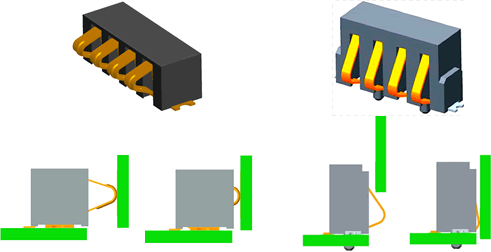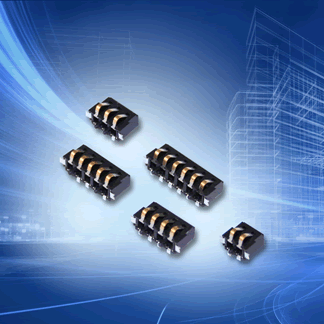The Evolution of Compression-Style Battery Connectors
For more than 20 years, modular industrial electronics have used many of the same reliable, ruggedized battery connectors that have been trusted throughout the consumer electronics industry. However, these devices are even more susceptible to host connector damage than modular consumer electronics. Now there’s a solution.
Electronic devices with removable battery modules designed to be replaced by users – which range from consumer devices like smartphones and tablets to industrial electronics like rechargeable walkie-talkies – often experience connector damage resulting from improper module removal or insertion. Ruggedized, compression-style battery connectors are typically specified for these applications due to the fact that they have long provided the most robust and forgiving modular mating solutions available on the market. However, when vertically mounted, even these ruggedized battery connectors require users to insert the module at a specified angle before snapping it into place to prevent the battery contacts from damage. If you have ever replaced the battery in your cell phone, you almost certainly know that this angled insertion isn’t always as easy, effective, and error-proof as it seems.
For more than 20 years now, modular industrial electronics have overwhelmingly employed many of the same reliable, ruggedized battery connectors that have been used and trusted throughout the consumer electronics industry. However, these devices are even more susceptible to host connector damage than modular consumer electronics. Unlike consumer devices, industrial electronics with pluggable modules are frequently designed to be mated and unmated 5,000 or more times, and the risk for connector damage worsens in direct relation to the number of module mating cycles.
Regardless of how robust and forgiving compression-style battery connectors may be, they can still produce the exact same failure mode as smaller, more fragile connectors when misused or misaligned. So, in addition to the standard electrical and mechanical requirements that design engineers must consider when selecting host connectors for modular devices, they must also try to account for human variables that go well beyond traditional CAD software calculations, since regular people, rather than trained technicians, are generally responsible for plugging the components together.
Compression-style battery connectors are uniquely challenging to design. These connectors must accommodate high mating cycles; absorb as much of a device’s component and assembly tolerances as possible while simultaneously maintaining electrical integrity with the module; and be easily and effectively mated by an unknown pair of hands; but they also must be able to function by themselves, often without any knowledge of the end contact that they will eventually mate with.

Figure 1: AVX’s 9155-500 Series right-angle 2.5mm-pitch battery connector (left) horizontally mates to the board, deflecting the contacts into the connector body. AVX’s new 9155-800 Series vertical-mate, 2.0mm-pitch battery connector vertically mates to the board, and the angled contacts easily deflect into the insulator.
To better understand the key design factors in compression connectors for demanding industrial applications, let’s first examine a typical vertical-mate smartphone battery connector. In this application, the connector needs to accept the battery pack, absorb the phone-to-pack assembly tolerances, and be as small as possible.
The miniature compression-style battery connector pictured on the left side of Figure 1 is less than 4.0mm tall to meet internal phone height parameters; exhibits significant contact deflection and force for electrical and mechanical integrity; and can easily be replaced by consumers. Most consumers rarely, if ever, replace the battery pack in their cell phone, though; this connector is unlikely to experience anywhere near as many mating cycles as one designed for an industrial device. As such, its contacts don’t have to be quite as robust.
The reason this particular connector was selected for a smartphone application was the extremely low height of its plastic insulator. To achieve this minimal height, the contact was designed to operate on a horizontal axis with the necessary deflection range and contact force. It requires users to carefully insert the battery pack at a 45-degree angle until it’s against the connector, and then gently rotate it down into the opening on the back of the phone so it audibly clicks into place, which sounds simple. However, any deviation in the angle, alignment, or force of insertion could quickly, easily, and permanently damage the connector.
Since modular industrial electronics risk significant damage with each of the thousands of vertical matings they are likely to experience, and the peak performance of these devices tends to be more critical than consumer devices, a new series of vertical-mate battery connectors was designed to prevent end-user damage to the contacts in electronic devices with pluggable modules that vertically mate with a base unit.

Figure 2: AVX’s 9155-800 Series vertical-mate compression connectors feature gold-plated beryllium-copper high-spring-force, high-cycle-life contacts in two- to six-pin configurations.
Engineers based the design of the new vertical-mate battery connectors on standard compression-style battery connectors due to their longstanding reputation for robust, reliable, and forgiving performance. The new connectors (Figure 2) feature a first-of-its-kind contact geometry that allows for full vertical engagement in pluggable module applications, eliminating the special loading angle previously required for vertical mating and essentially neutralizing the potential for mating-related contact damage.
The new design was driven primarily by user engagement rather than physical dimensions. Engineers increased the insulator height to 5.0mm and extended the length of the contacts, which now exhibit a long sweeping motion. They also incorporated an anti-snag feature into the contact tips to protect them during deflection and added plastic locating bosses and SMT anchor tabs to maximize the mechanical stability of the connectors in harsh conditions. These features, combined with the superior electrical performance of the connectors’ gold-plated beryllium copper (BeCu) contacts, ultimately resulted in a series of robust, low-profile battery connectors that are extremely forgiving during the mating process, when plastic tolerance allowances are very high and the connector needs to absorb mismatches without damage. Once mated, the new high-spring-force connectors effectively maintain electrical integrity throughout the lifetime of the product.
By starting with a proven compression connector design and optimizing the contact materials and geometries to suit specific applications, engineers were able to dramatically reduce the potential for mating-related connector damage.
This article will appear in ConnectorSupplier.com’s upcoming eBook, The Industrial Connector Handbook.
Author Tom Anderson is connector product manager at AVX.
Recently added:
[related_posts limit=”10″]




